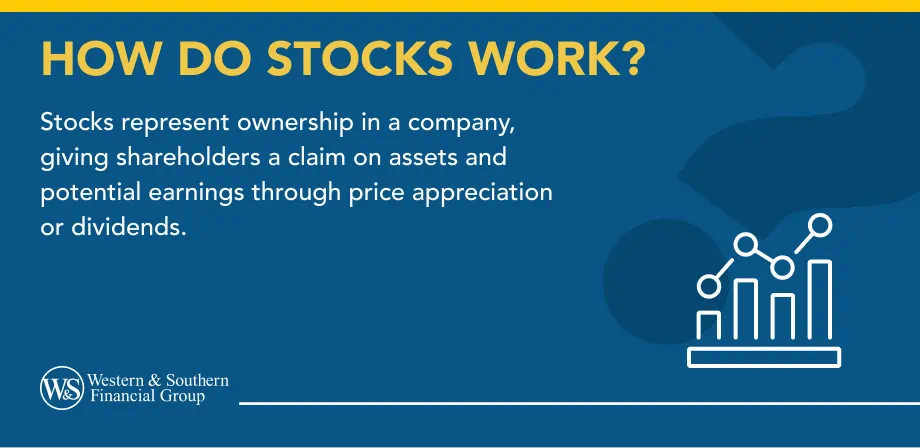Table of Contents
Table of Contents


Key Takeaways
- Each unit of stock is called a share, allowing investors to share in a company's profits if successful.
- Stocks can grow in value through price appreciation and may also pay dividends to shareholders.
- Investors can invest in stocks directly by buying shares or indirectly through stock mutual funds or ETFs.
- Investors buy shares of stock through financial institutions, typically starting with an investment account.
- Before purchasing stock, investors should decide which shares to buy and determine their investment amount.
It's likely that you've heard all kinds of jargon related to stocks over the years. Even if you have a basic understanding of investing and the market, you might still wonder — how do stocks work, and what are the different types? It's not just you — many people are unfamiliar with how penny stocks, dividends and trading works.
Put simply, stocks represent ownership in a company. They are investment assets that offer investors a means of participating in a company's profits. Here's a closer look at stocks and how to get started investing.
Understanding How Stocks Work
Each unit of stock is known as a share. Owning shares of stock offers investors a means of sharing in the profits of a company if it is successful. Stocks may grow in value through price appreciation. Stocks may also pay dividends to shareholders. Of course, it's important to understand that investments cannot guarantee growth or sustainment of principal value; they may lose value over time. Past performance is not an indication of future results.
Wondering, "How do penny stocks work?" As the name implies, penny stocks are stocks that are low-priced, generally under $5 per share. Like most other stocks with higher prices, penny stocks can trade on an exchange, such as the New York Stock Exchange (NYSE). However, most penny stocks trade with over-the-counter (OTC) transactions on OTC Markets.
Here are some terms to know related to investing in stocks:
- Share ownership: When you invest in stocks, you are buying shares of ownership in a company.
- Price appreciation: When you buy shares, you generally will buy the shares at the market price at the time of purchase. If the company is profitable, the share price may rise, which increases the value of your original investment.
- Dividends: When a company has positive earnings, they may make cash payments to shareholders in the form of dividends.
- Compound growth: Part of what may increase the value of an investment in stocks is something called compound growth, which can see money grow exponentially over a period of time.
Different Types of Stock Investments
Investors can invest in stocks either directly or indirectly. A direct investment is made by buying and holding shares of individual stocks. An indirect investment in stocks can be made primarily through the purchase of stock mutual funds or equity-based exchange-traded funds (ETFs).
- Mutual funds: When an investor buys shares of a stock mutual fund, they are buying a basket of stocks held within the fund. Thus, the investor owns shares of the mutual fund, not the stocks.
- ETFs: These funds typically seek to passively track the price of an underlying benchmark, such as the S&P 500 index. Although the S&P 500 is a stock index, the ETF investor owns shares of the ETF, not the stocks in the fund or the index.
Different stock options offer unique benefits for building wealth. Invest In My Future
7 Steps to Get Started Investing in Stocks
Investors can buy shares of stock through a financial institution. To get started investing, an investor will need to first open an investment account. Once the account is open, it will need to be funded with cash for purchasing shares of stock. Before buying stock, investors should determine which shares to buy and how much to invest.
Here are seven steps to take when getting started with investing:
- Choose a financial institution. Investors may choose to invest through a range of financial institutions, including a discount online broker, a full service broker, a bank, a mutual fund company and some insurance companies.
- Work with a stockbroker. Stockbrokers are financial professionals who can handle market transactions on behalf of their client. They can help you make informed decisions and provide valuable advice.
- Open an investment account. There are multiple types of investment accounts, including a traditional brokerage account, a joint brokerage account, an individual retirement account (IRA), a 529 savings plan and employer-sponsored retirement plans, such as a 401(k).
- Fund the account. You'll need money in the account to buy shares of stocks or stock funds. This can be accomplished quickly by completing an electronic deposit or arranging for a physical deposit.
- Research and choose stocks. There are many different types of stocks, whether broken down by style, such as growth stocks or value stocks, or by market capitalization, such as small-cap, mid-cap or large-cap stocks.
- Determine the size of your desired position. Stocks are generally purchased by a number of shares, and the minimum initial investment amount is typically one share. So, if you want to invest $500 in a particular stock and the share price is $100, you may purchase five shares.
- Execute the trade. When you buy or sell shares of stock, it's called a "trade." Executing the trade is simply done by submitting your request to buy a certain number of shares and submitting the trade at a market price.
- Determine your desired holding period. Stocks are typically most suitable for long-term holding periods such as 10 years or more. The holding period is often determined by an objective, such as retirement, so give some thought to your individual needs.
Bottom Line
Next time you're asked "how do stocks work?" or "how do penny stocks work?" you'll be able to explain that investors may buy stocks — which represent ownership in a company — through a financial institution. Over time, stocks can grow in value through price appreciation and dividends, but this isn't guaranteed. Investors typically invest in stocks for long-term growth objectives, such as retirement, and may invest on their own or with the help of a professional.
If you find you have additional questions, consider reaching out to a financial professional for more insight. These knowledgeable individuals can take a personalized look at your unique situation and help to formulate a plan for reaching your financial goals.
Gain long-term growth potential by adding stocks to your investing strategy. Invest In My Future
























